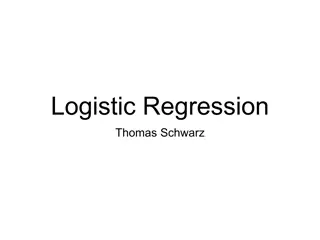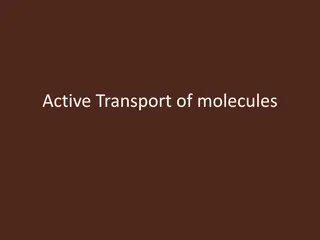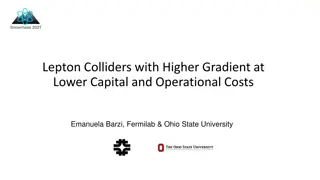Do Input Gradients Highlight Discriminative Features?
Instance-specific explanations of model predictions through input gradients are explored in this study. The key contributions include a novel evaluation framework, DiffROAR, to assess the impact of input gradient magnitudes on predictions. The study challenges Assumption (A) and delves into feature leakage using the BlockMNIST dataset. Furthermore, the efficacy of adversarial training in enhancing model robustness and the limitations of existing gradient-based attribution methods are discussed.
Download Presentation

Please find below an Image/Link to download the presentation.
The content on the website is provided AS IS for your information and personal use only. It may not be sold, licensed, or shared on other websites without obtaining consent from the author.If you encounter any issues during the download, it is possible that the publisher has removed the file from their server.
You are allowed to download the files provided on this website for personal or commercial use, subject to the condition that they are used lawfully. All files are the property of their respective owners.
The content on the website is provided AS IS for your information and personal use only. It may not be sold, licensed, or shared on other websites without obtaining consent from the author.
E N D
Presentation Transcript
Do Input Gradients Highlight Discriminative Features? Authors: Harshay Shah, Prateek Jain, Praneeth Netrapalli Presenters: Karly Hou, Eshika Saxena, Kat Zhang
Introduction Instance-specific explanations of model predictions Input coordinates are ranked in decreasing order of input gradient magnitude Assumption (A): Larger input gradient magnitude = higher contribution to prediction
Key Contributions New evaluation framework DiffROAR for evaluating Assumption (A) on real datasets compares the top-ranked and bottom-ranked features Evaluate input gradient attributions for MLPs and CNNs Found that standard models violate Assumption (A) Some adversarially trained models might satisfy it
Key Contributions: BlockMNIST Dataset Each datapoint contains two images, a signal (the actual digit), and a null block (a blank square) Want to see if the classification is actually occurring as a result of the block with the information
Key Contributions: BlockMNIST Dataset Feature leakage is a potential reason why Assumption (A) is violated Feature leakage is shown empirically and proved theoretically
Related Work Sanity checks for explanations Visual assessments are unreliable Other well-known gradient-based attribution methods fare worse in these sanity checks Evaluating explanation fidelity Evaluations traditionally performed without knowing the ground-truth explanations Usually evaluated using masking or ROAR Input gradients lack explanatory power and are as good as random attributions
Related Work Adversarial Robustness Adversarial training can improve the visual quality of input gradients Adversarial model gradients are more stable than standard ones Are they also more faithful?
Setting Standard classification setting with each independently drawn data point as a pair of (instance, label): x(i)jdenotes jth coordinate/feature of x(i) Feature attribution scheme maps a d-dimensional instance x to a permutation of its features e.g. Input gradient attribution scheme takes input instance x, predicted label y, outputs ordering [d] that ranks features in decreasing order of input gradient magnitude
Unmasking Schemes Unmasked instance xSzeroes out all coordinates not in subset S Unmasking scheme maps instance x to subset A(x) of coordinates to obtain unmasked instance xA(x) Top-k and bottom-k unmasking schemes:
Predictive Power of Unmasking Schemes Predictive power: best classification accuracy that can be attained by training a model with architecture M on unmasked instances that are obtained via unmasking scheme A Estimate predictive power in two steps: (1) Use unmasking scheme A to obtain unmasked train and test datasets that comprise data points of the form (xA(x), y) (2) Retrain a new model with the same architecture M on unmasked train data and evaluate its accuracy on unmasked test data
DiffROAR Metric Interpretation of the metric: Sign of the metric indicates whether the assumption is satisfied (> 0) or violated (< 0) Magnitude of the metric quantifies extent of separation of most and least discriminative coordinates into two disjoint subsets
Experiment 1: Image Classification Benchmarks
Setup: Datasets and Models Datasets: SVHN, Fashion MNIST, CIFAR-10, ImageNet-10 Models: Standard and adversarially trained two-hidden-layer MLPs and Resnets Adversarial: l_2 and l_ epsilon-robust models with perturbation budget epsilon using PGD adversarial training
Procedure: Computing DiffROAR Metric As a function of unmasking fraction k, compare input gradient attributions of models to baselines of model-agnostic and input-agnostic attributions: 1. Train a standard or robust model with architecture M on the original dataset and obtain its input gradient attribution scheme A. 2. Use attribution scheme A and level k (i.e., fraction of pixels to be unmasked) to extract the top-k and bottom-k unmasking schemes: A top k and A bot k
Procedure: Computing DiffROAR Metric 3. Apply A top k and A bot k on the original train & test datasets to obtain top-k and bottom-k unmasked datasets respectively (unmask individual image pixels without grouping them channel-wise) 4. Estimate top-k and bottom-k predictive power by retraining new models with architecture M on top-k and bottom-k unmasked datasets respectively and compute the DiffROAR metric. 5. Average the DiffROAR metric over five runs for each model and unmasking fraction or level k
Analyzing input gradient attributions: BlockMNIST data Dataset design based on intuitive properties of classification tasks: Object of interest may appear in different parts of an image Object of interest and the rest of the image often share low-level patterns like edges that are not informative of the label on their own Standard + adversarially robust models trained on BlockMNIST data attain 99.99% test accuracy.
Do gradient attributions highlight signal block over null block? Not always!
Feature leakage hypothesis When discriminative features vary across instances (e.g. signal block at top vs bottom), input gradients of standard models may not only highlight instance-specific features but also leak discriminative features from other instances Altered datasets: BlockMNIST-Top now gradients of standard Resnet18, MLP highlight discriminative features in signal block and suppress null block
Dataset Simplified version of BlockMNIST Draw sample eta = noise parameter g_i drawn uniformly at random from the unit ball Let d even so that d/2 is an integer We can think of each x as a concatenation of blocks {x_1 x_d} The first d/2 blocks are task-relevant: each example contains an instance-specific signal block that is informative of its label The remaining blocks are noise blocks that don t contain task- relevant signal At a high level, these correspond to the discriminative MNIST digit and null square patch in BlockMNIST :
Model Consider one-hidden layer MLPs with ReLU nonlinearity Given an input instance, the output logit f and cross-entropy loss L are (for given layer width m) As m infinity, the training procedure equivalent to gradient descent on infinite-dimensional Wasserstein space Wasserstein space: network interpreted as probability distribution nu with output score, CE loss:
Theoretical analysis Prior research shows that if gradient descent in the Wasserstein space converges, it does to a max-margin classifier: S = surface of Euclidean unit ball P(S) = space of probability distributions Intuitively, our results show that on any data point (x, y) ~ D, the input gradient magnitude of the max-margin classifier v* is equal over all task-relevant blocks and zero on noise blocks
Theorem Guarantees existence of max-margin classifier such that the input gradient magnitude for any given instance is a nonzero constant on the task-relevant blocks, and zero on noise blocks However, input gradients fail at highlighting the unique instance-specific signal block over the task-relevant blocks Feature leakage: input gradients highlight task-relevant features that are not specific to the given instance
Empirical results One-hidden-layer ReLU MLPs with width 10000 All models obtain 100% test accuracy Due to insufficient expressive power, linear models have input-agnostic gradients that suppress noise but do not differentiate instance-specific signal coordinates
Discussion and Limitations Assuming that the model trained on the unmasked dataset learns the same features as the model trained on the original dataset When all features are equally informative, ROAR/DiffROAR can t be used This work only focuses on vanilla input gradients Why does adversarial training actually mitigate feature leakage?
Conclusion Assumption (A): Larger input gradient magnitude = higher contribution to prediction Assumption (A) is not necessarily true for standard models Adversarially robust models satisfy Assumption (A) consistently Feature leakage is the reason why Assumption (A) does not hold
Discussion Questions After seeing that the fundamental assumption regarding the correspondence between input gradients and feature importance may not hold, do we still find post-hoc explanations for individual or groups of data points convincing? What are other major assumptions in explainability that we ve discussed that you think could benefit from a sanity check with an approach similar to this paper? Do you have any additional doubts about any of the approaches taken in this paper?























